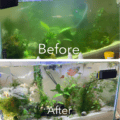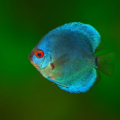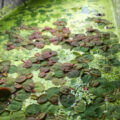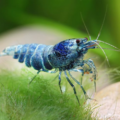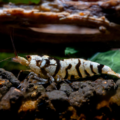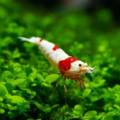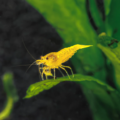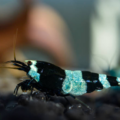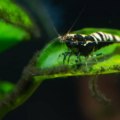Nature’s algae-eaters are chemical-free and an entertaining way to clean your aquariums. This is your complete care guide to maintaining the translucent Amano Shrimp.

Are you looking for natural ways to clean your aquarium tank without disturbing the aquascaping? I’m excited to introduce you to the Amano Shrimp, a freshwater algae-eating shrimp known for its exceptional capabilities as a peaceful and natural tank cleaner.
This traditional Japanese water-dweller gained popularity through the famous aqua-trader Takashi Amano.
In this Caridina multidentata overview, you’ll learn ways to identify this species, create its ideal habitat, feed, breed, protect, maintain, and ensure optimal Amano Shrimp care.
You’re about to start an exciting journey, so keep an open mind and a ready hand to work!
Quick Sidenote: Do you want to watch this article instead of reading it? Checkout the highlight video below from our YouTube Channel (Or read the more detailed article below), be sure to Subscribe For More Great Fishkeeping Content:
Identifying Amano Shrimp: Key Features
Identifying Amano shrimp could be done through physical appearance or traits.
Color Pattern

Amano shrimp grow up to ~2-3 inches (~5-7cm) long in adulthood and have a translucent body with horizontal dotted marks. So, although they’re a dwarf species, their size makes them some of the bigger variants for their kind.
These Caridina shrimps’ translucent bodies range from gray to brown despite being clear and almost see-through.
Unique Traits
Other unique traits of this Algae-eating Caridina Shrimp include its strong appetite for algae and biofilm, peaceful temperament, and adaptability, which makes it thrive in varied tank setups.
These peaceful freshwater shrimp traits are why Amano Shrimps are perfect additions as natural cleaners in an aesthetic tank with delicate aquascaping and small, non-aggressive fish.
See Also: 20 Hair Algae Eaters for a SPOTLESS Aquarium
Creating the Ideal Habitat for Amano Shrimp

Get out your note pad because I will lay down the guidelines for an ideal Amano Shrimp tank setup!
Before we start, a few facts to note include this species’ adaptability to different water conditions, its love for foraging and hiding, and its need for clean water. Now, you’re ready for the details.
Tank Size and Layout
I recommend a minimum tank size of 10 gallons for a small group of Amano Shrimps, keeping in mind the five shrimp per gallon rule. This size should remain the same even with plants, driftwood, and other aquascaping.
When designing the aquarium layout for algae eaters, use driftwood, rocks, and plants to create hiding spots and encourage foraging for food.
Water Parameters
Set the ideal water parameters to mimic the traditional Japanese Caridina multidentata habitat for the best living conditions. Always ensure the stability of water conditions because fluctuations lead to stress and other health issues.
| Temperature | 68 – 82℉ |
| pH | 6 – 7.5 |
| Hardness | 4 – 14 dGH |
Adjust the water’s hardness periodically for comfort. Without maintaining proper water parameters, the tank’s water quality can degrade, which can cause a wide range of issues from cloudy aquarium water to illness and mass fish die off.
Feeding Amano Shrimp: Supporting Their Natural Role
Although Amano Shrimps love algae, you can’t let it be their only meal. Monitor their shrimp diet for algae control by including supplemental food in their daily meals.
Diet Suggestions
Primary/Staple Food: Algae and Biofilm
Supplements: Sinking pellets, protein-based meals in flakes or freeze-dried form, and occasional blanched vegetables.
Balanced Shrimp Nutrition gives your pets healthy skin and aids their overall wellbeing.
For more on feeding your aquatic pets check out The Ultimate Guide to Fish Food: Pros and Cons & Best Choices!
Feeding Tips
Follow these tips for feeding Amano Shrimp to avoid overfeeding, waste, or malnutrition.
- Provide food in small quantities consumable under two minutes
- Place food in the substrate to encourage foraging behavior
- Feed only two to three times daily.
Breeding Amano Shrimp: Challenges and Solutions

Breeding Amano Shrimp in captivity is challenging because of the technicalities of its environment. Unlike adult Amano shrimps, you need brackish water, not fresh water, to raise Amano shrimp larval.
So, follow these tips for successful breeding and larva care:
Breeding Setup
| Male Amano Shrimp | Female Amano Shrimp |
| 1.5 – 2.5 inches large | 2 – 3 inches large |
| Longer bodies | Rounder bodies |
| No saddle, No eggs | Saddle shape on the back of the head to carry eggs |
This video has been very helpful in identifying the sex of caridina Shrimp, I highly recommend it:
You’ll need two breeding tanks for Caridina multidentata reproduction, and here’s why –
The adults mate in freshwater and lay their eggs there, after which you must transition the larvae into brackish water for proper development.
Keep the water temperature at 72 – 78℉, add protein and calcium to the breeder’s diet, and maintain an oxygenated environment.
Larval Care Tips

The female Amano shrimp will carry her fertilized tiny greenish eggs in her swimmerets (underside of their body) for three to five weeks. Afterward, they’ll hatch into free-swimming larvae that you must move to brackish water for survival.
Brackish water parameters
| Salinity | 15 – 20 ppt (Use marine salt) |
| Temperature | 75 – 80℉ |
Immediately feed them microalgae, powdered spirulina, or specialized fry food thrice daily because they need enough nutrients to grow.
After 4-6 weeks, the larvae will transform into shrimps through molts, and then you can return them to the freshwater habitat. Take your time with the transition, though. First, reduce the salinity in the brackish tank within 1-2 weeks to prepare your shrimp for life in the freshwater tank.
See Also: 18 Brackish Water Aquarium Fish (Cool Oddballs)
Compatible Tank Mates for Amano Shrimp
Amano shrimp are peaceful aquarium companions and can coexist with other fish and invertebrates, but they’ll only survive in a community tank if you choose shrimp-safe tank species as their companions.

| Compatible Species | Avoided Species |
| Tetras, Rasboras, Snails, small peaceful species | Large or aggressive fish that could prey on Amano shrimp |
See Also: Discover 14 Popular Freshwater Snail Species for Your Aquarium
Maintaining Healthy Conditions for Amano Shrimp
The most common health issue in amano shrimp is molting problems caused by stress from fluctuating water parameters. Use these Amano shrimp health tips to prevent and address health concerns.
Without maintaining proper water parameters, the tank’s water quality can degrade, which can cause a wide range of issues from cloudy aquarium water to illness and mass die off.
Preventative Measures
Maintain stable water quality with regular tank maintenance and water changes. Also, avoiding copper-based meds helps in preventing shrimp illnesses because they’re toxic for the species.
Signs of Illness
If you notice any of these patterns in your Amano shrimp, it’s a sign of illness, and you should treat it immediately;
- Inactivity
- Failed molts
- Fading color
As this guide has shown, maintaining healthy Caridina Shrimp starts with optimal tank care and feeding a balanced diet.
Lifespan of Amano Shrimp: Caring for Long-term Companions
Proper freshwater shrimp health management allows your pets to live up to 2-3 years. However, you must adopt the key practices in this Amano Shrimp lifespan guide to achieve this result.
Let’s start with highlighting lifespan factors and then finish with tested and trusted tips on long-term care for algae-eating shrimp.
Lifespan Factors
- Diet
- Water quality
- Compatibility with tank mates
Care Tips for Longevity
You must be consistent in your observation to note anomalies and tackle them immediately. However, adopting proactive care routines is better than reacting.
Conclusion: Why Amano Shrimp Are a Top Choice
That’s the end of this Amano Shrimp care guide.
Today, you’ve learned about all the care essentials for giving Caridina multidentata a healthy life. You know about its algae-eating abilities, peaceful temperament, easy maintenance practices, and health care.
The only complex part of this species’ lifestyle is its breeding, and thanks to this complete shrimp care guide, you can handle it.
Also, remember that when you add the Amano Shrimp to your aquarium for natural tank maintenance, you must adopt aquarium algae control tips to balance their nutrition.


